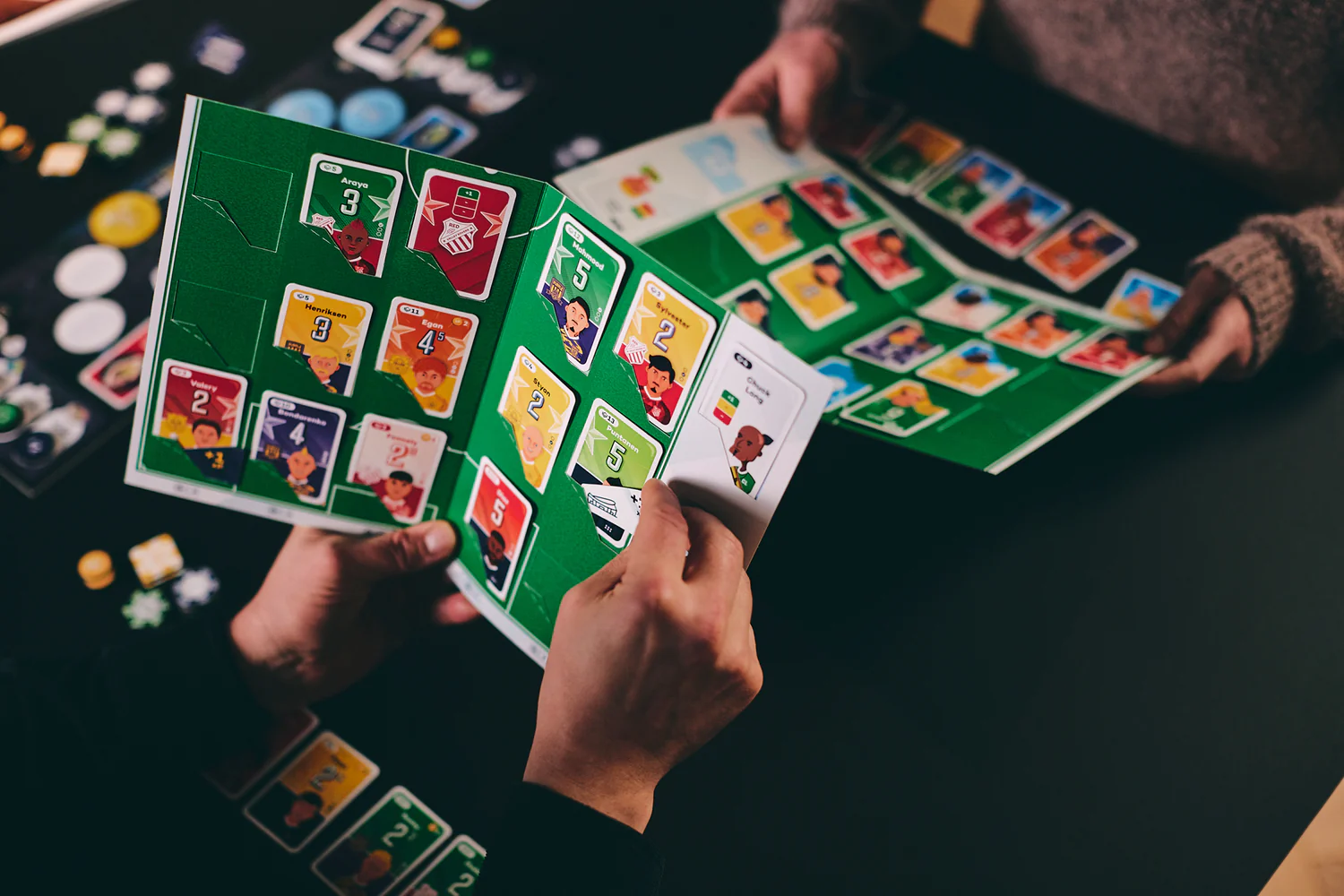Table of Contents
Superclub Rivals is the latest offering from the team who brought us the incredible Superclub. It is a new, more manageable, streamlined, and faster game of Superclub for two players.
If you have played even one game of Superclub you’ll instantly recognize several aspects of the new game but at the same time, if this is your first experience of a football management game, I think you may be surprised at how “gamey” it is.
Superclub: Rivals is coming to Kickstarter very soon. You can follow the project now to get notified when it goes live. At the time of writing, I do not have details about the Kickstarter reward tiers or a definitive price point I am happy to share, but I am sure being a Kickstarter there will be benefits that will tease the money from your wallet and an initial offering that will be below retail.
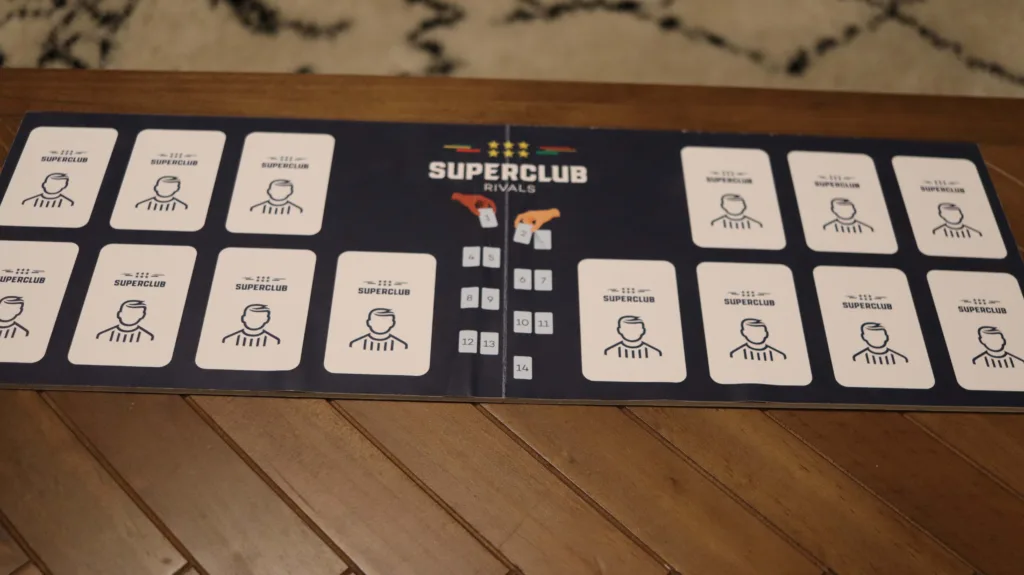
Superclub Rivals’ First Impressions
Look, Superclub is incredible, it’s the best football management board game in existence and we play it a lot so I was unsure if the smaller, lighter game that is Superclub Rivals would be something I would want, considering I have invested heavily into the latter.
When I was offered the chance to take a look at a new game, Superclub Rivals, I was quite excited, a new game based around a familiar and enjoyable mechanic.
I jumped at the chance. Before I carry on, however, I want to start by saying that I have been sent the prototype version of the game so the retail version will likely be very different in terms of materials used and the quality of the components.
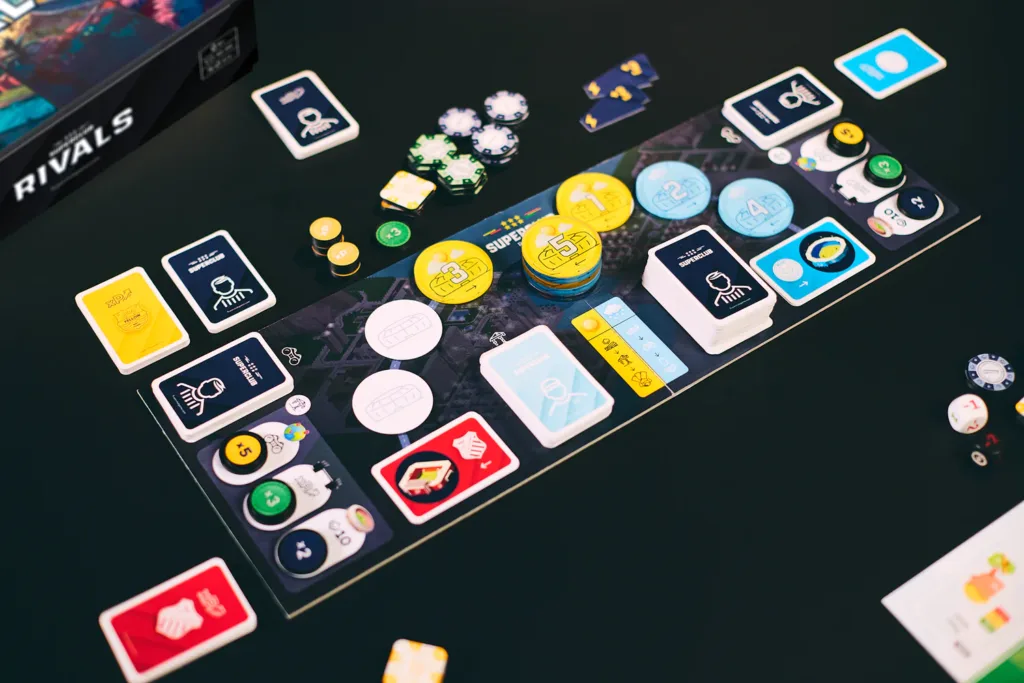
For this very reason, whilst I will talk about the game and gameplay you must understand that things may change, I will not be able to comment on the quality of the components other than the aesthetic and the overall feel of the design.
To highlight this the Summer and Winter tokens were cut from some very thick acrylic giving the game a very premium feel, the actual game will probably ship with card tokens meaning the feeling and table presence will be a very different affair.
I hope that makes sense regarding what I am about to tell you.
Setting up Superclub: Rivals
The rule book says you are first supposed to decide who is Manager A, the left side of the board, and Manager B, the right side of the board but this is as pointless a step as a Car manual saying, “First open the door before stepping out of the car” and serves as an example to explain why I am going to go off script a little and tell you the way we set up, the result is the same but its faster and just made more sense.
Place the board draft side up and pick teams. For Superclub aficionados you will instantly recognize Blue Mountain United, Red Valley Rovers, Purple Plain Athletic, and Yellow Bay Town and it did feel like seeing some familiar friends at a new bar.
Still, there is a difference, in Superclub Rivals each team has a special set of 7 core players and 15 shortlisted players.
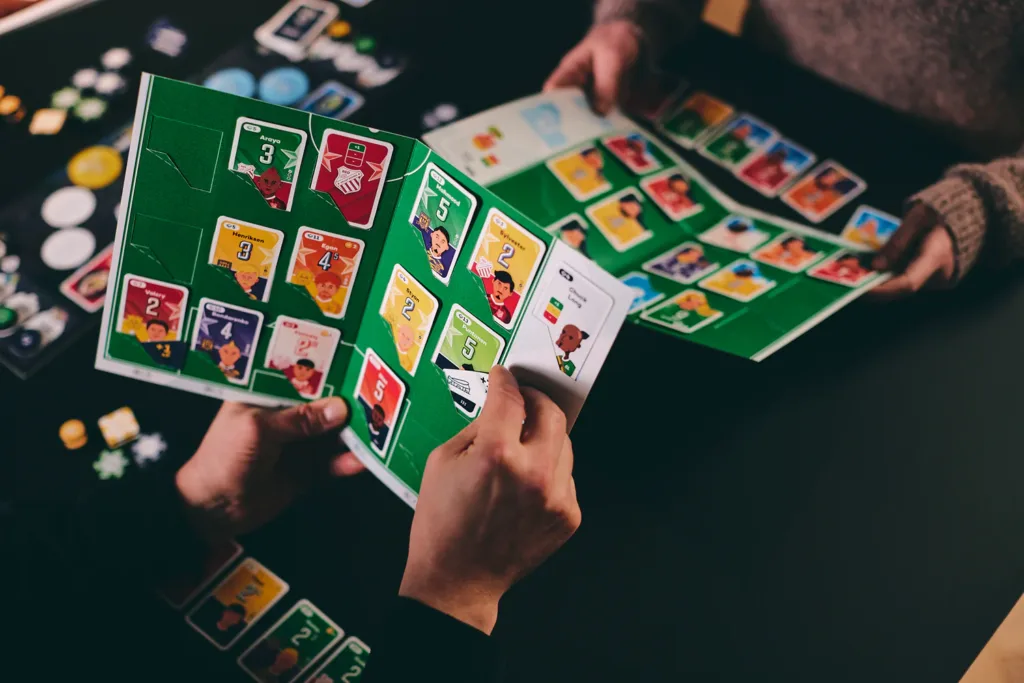
Core players are identified by a silver star near their number and one of these players will have a development option.
I will talk about the core players in more detail a little later but for now, we will continue with setup.
Then begins the draft, each player taking turns to select their squad in what is known as a “snake draft”. This means the first manager selects one player, the second manager selects two players and the two-player selection continues until there is one remaining player for manager 2.
During the second round of drafting player 2 begins the selection process.
Once the draft is completed you flip the board, shuffle each other’s shortlisted players, and place them face down near your investment section of the board.
While one of you shuffles the Key Staff cards the other shuffles the stack of player cards and you place these on the board.
We now like to shuffle each other’s 3 Club Identity cards and then hold them out, the opposing manager selects their Club Identity card and we keep it secret until the first match. The Club Identity cards give you a plus one in either attack, midfield, or defence.
Next, we placed the match day tokens onto the board, these were thick acrylic tiles in our prototype version but will more than likely be card tokens in the final version. These are numbered 1-8 plus the final token and represent not only the match number but also if it’s a home or away game and the season with 4 being yellow summer season tokens, 4 being blue winter season with a final Summer/Winter season representing a Cup Derby.
These are stacked in order so that the final cup token is on the bottom followed by the blue 8th match to the 1st match token at the top.
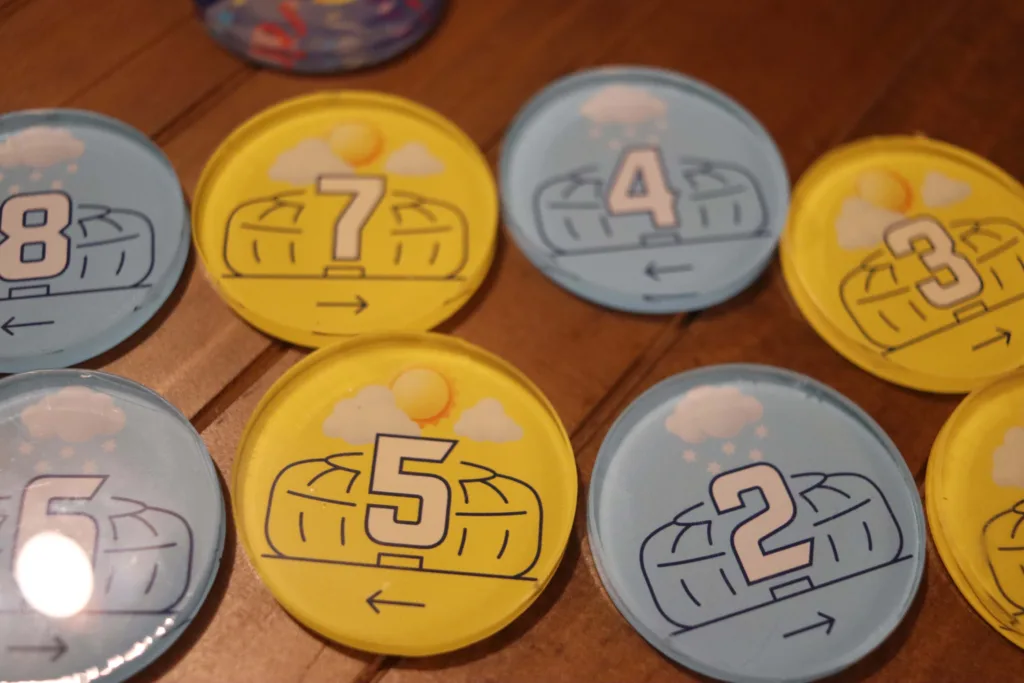
Core players and teams
So, this is going to be a little complicated to explain but I said I would talk about core players later so I could get through the setup in one go. It’s important to address this now as you need to analyse your team before the draft so that you can make good picks.
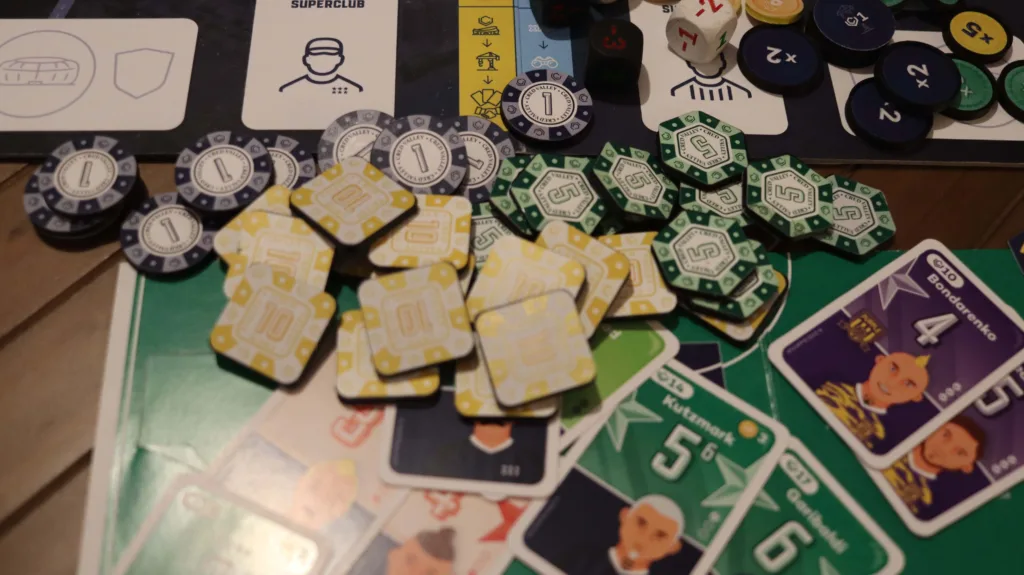
Unfortunately, before I can do that, I must make you aware of the new-look player cards. Firstly, I love them, and secondly, there is a surprising amount of information available on each card.
The cards are split in two, the top colour representing the player’s position and the bottom part of the card showing their team affiliation.
If you are not familiar with Superclub then you should know that Green represents attackers, yellow midfield and Red defence. Additionally, Keepers are represented by a light pink but there are special players, these are Lime Green means a player can play Midfield or Attack without penalty and Orange means a player can be placed in Midfield or Defence without penalty whilst a purple player can be placed in any outfield position without penalty.
The penalty is essentially one point for every position away from their natural place. For example, a green attacker would face a one-point penalty for playing in Midfield and a two-point penalty for playing in defence.
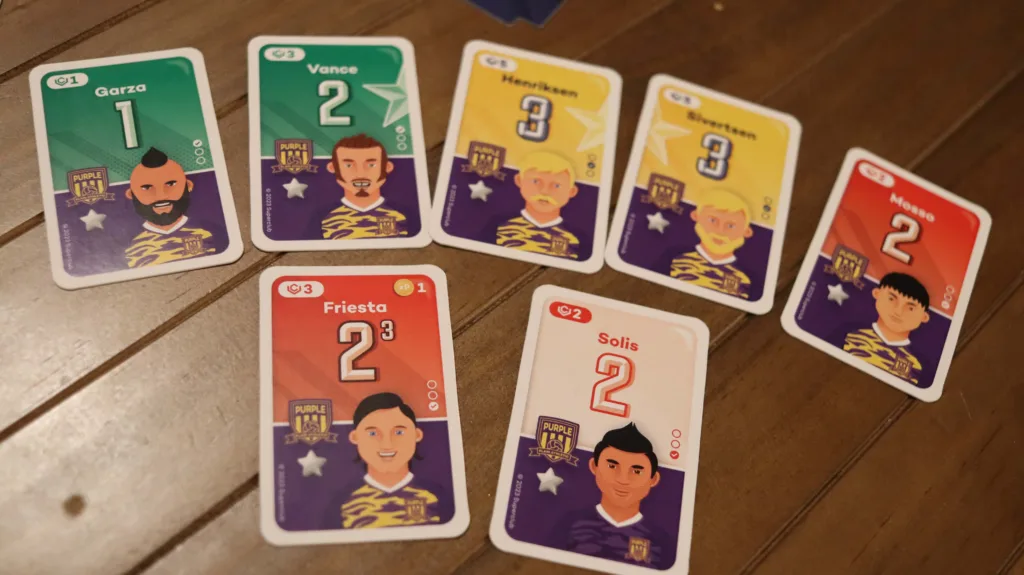
In the top portion of the card you will find a credit value in a white box, the total points a player is worth is represented by a large number in the middle of the card which is accompanied by a smaller number that represents their potential plus an XP cost to develop the player. In the top half of the card, there may also be half stars that represent chemistry with other players when you match these stars.
Finally, 3 small circles will contain ticks that represent where a player can play just in case you cannot remember what the colours mean.
In the bottom half of the card is the player’s club affiliation and a portrait of the player. The cards look fantastic and I wish they were available for Superclub.
Team Strengths and Weaknesses Explained
Each core team has different strengths and weaknesses. As an example, I will try to explain how a game between Purple Plain Athletic and Yellow Bay Town would play out if there was no draft.
CLICK FOR A FULL DETAILS
From now on I will refer to Purple Plain Athletic as PPA and Yellow Bay Town as YBT, the different strengths and weaknesses are represented by points allocated to their core players.
PPA:
Midfield (Mid): 6 points from players but there is a chemistry point available if played in the right position.
Attack (At): 3 points
Defence (Def): 4 points
Goalkeeper (Keep): 2 points
YBT:
Midfield (Mid): 3 points
Attack (At): 4 points
Defence (Def): 3 points with an additional chemistry point available
Goalkeeper (Keep): 2 points
Here’s how the match progresses:
Midfield Battle:
PPA Mid (7 points) vs YBT Mid (3 points)
PPA has a stronger midfield with 7 points compared to YBT’s 3 points.
So, PPA takes control of the midfield.
PPA Attack vs YBT Defense:
PPA Attack (3 points) vs YBT Defense (4 points)
YBT has a stronger defence with 4 points compared to PPA’s attack with 3 points.
YBT successfully defends against PPA’s attack.
YBT Attack vs PPA Defense:
YBT Attack (4 points) vs PPA Defense (4 points)
Both teams have equal strength in this matchup with 4 points each.
So when you pick your team your core players will have an impact on your selections during the draft and we found, like with Superclub we were often picking players that would hinder our opposition as well as help ourselves.
The Draft and Gameplay
The draft is one of the best things in Superclub and it is no different in Superclub Rivals except that you only have to consider one other manager’s picks.
Once the game begins you start with an off-season. There are two types of off-season and you carry out different tasks during each off-season.
In the summer season, you get your Stadium income and make investments followed by a Transfer Window, during the winter off-season you can take care of Training and Scouting followed by another Transfer Window.
Your stadium income is listed on your side of the board, and it is 10 credits x whatever upgrades you have made. This works incredibly well as it not only lets you see where you are with your investments but also lets you track your opposition with just a glance.
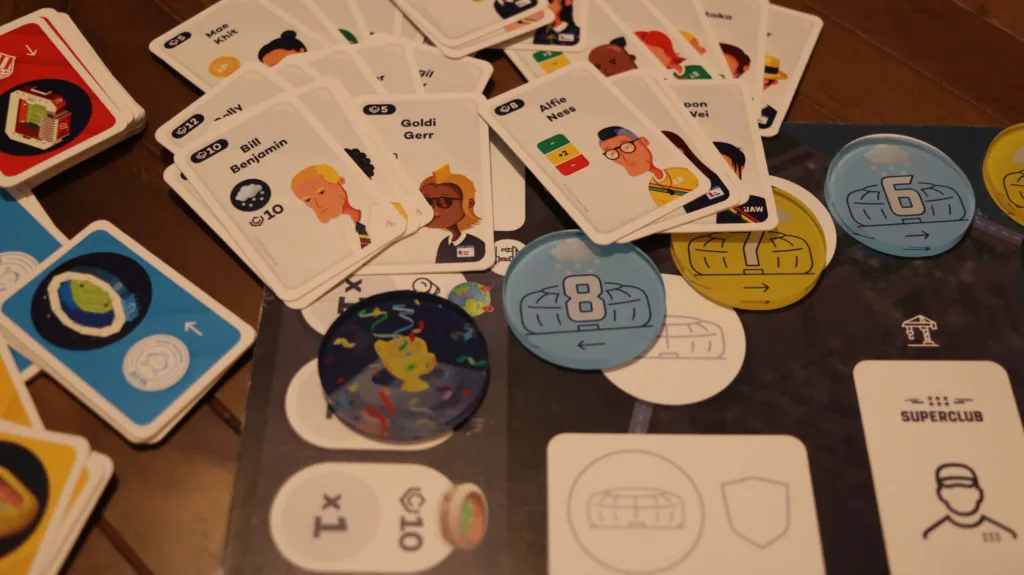
This is the same principle for Training and Scouting, however, only the fools will not fully upgrade their stadium for maximum income as soon as possible so perhaps there could be more variation for upgrades.
We played around with several D20 dice giving us more variation, but it is almost impossible for two people to play test a mechanic effectively so eventually gave up and went back to the standard game.
We did feel this is one area of the game that could be improved upon to give more strategic depth but how it would be implemented is best left to real game designers.
During the investment phase, you can take two actions: either upgrading the stadium, training, scouting or hiring a key staff member.
The Transfer window works by flipping three cards one at a time from the main player deck and bidding on each player. The highest bidder wins and the player must be paid for before flipping the next player. We love the transfer window in Superclub Rivals and despite the odd dud coming through it’s one of the most competitive areas of the game as winning a player to stop the other manager from getting them into their team is often as important as winning the player you want.
The competition in the transfer window adds a layer of excitement to the game that you will only be able to fully appreciate through playing the game. It will need to matter to you and hoarding some money for this part of the game is so exciting we house-ruled a hidden bank, so we did not know how much each other had.
Briefly touching on the credits in the game I wanted to say how incredible the tokens are over the paper money from Superclub.
Instead of weak and flimsy notes, there were foam core tokens representing the game’s money and if these had been included with Superclub I would probably not have proxied in poker chips.
They work incredibly well and have a lovely feel but I should remind you that this is a prototype and I would imagine these would be made from card in the final version of the game.
I should point out this is probably true for the investment tokens too which were made from a hard plastic in the prototype.
There is an arrow on the match tokens which will point to either side and this team gains a home advantage in the form of a boost. In the same way Captains boosts work the team gains a plus one.
These boosts along with the captain’s boost for the losing side can be a game-changer as matches are often very close affairs.
Matchday in Superclub Rivals
You begin play by fielding a team in one of the 8 legal formations and set your players out accordingly. This will give you an attack, midfield and defensive point total.
Matches work by first counting the points in midfield including bonuses from key staff, club identity cards, home advantage and motivation (captains boosts), now total chemistry stars, these are half-stars from player cards that marry other half-stars and form full stars. You then roll your two dice.
This is not just a simple case of adding the numbers from the dice and hoping for no doubles, in Superclub Rivals the dice have + and – symbols.
It means your 10-star defence could pull off a 13-star performance, or you may roll a circle with a + symbol inside and injure your best player for a few games!
Remember those agonizingly tense late-season Superclub matches where promotion or glory hung in the balance?
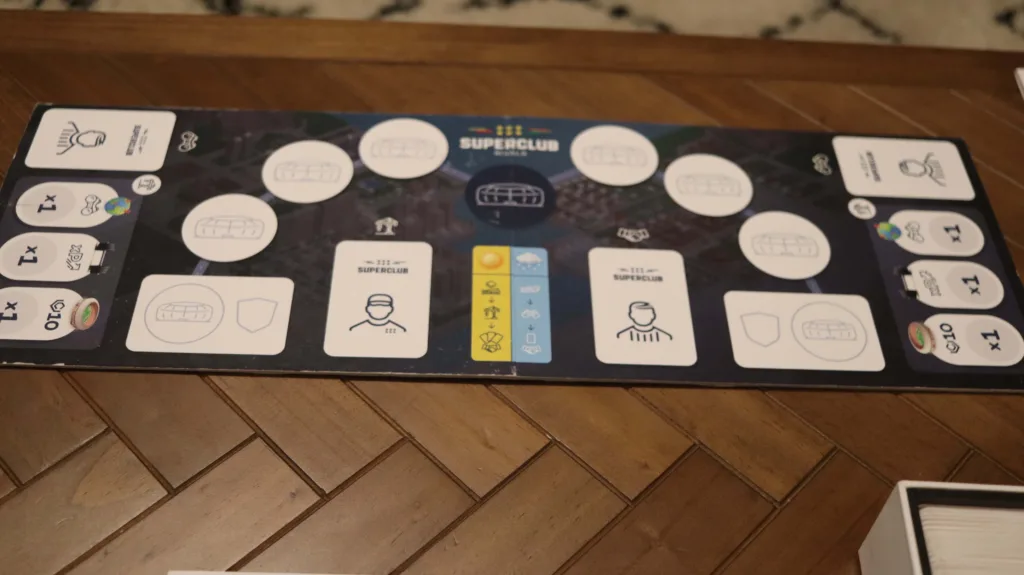
The ones where a single dice roll could shatter your dreams? Superclub Rivals captures that heart-pounding intensity and injects it into every single matchup, transforming routine encounters into high-stakes battles.
Forget forced smiles and hollow victories. Superclub Rivals throws you into a constant struggle where every midfield duel, every attacking surge, and every defensive stand feels like a life-or-death fight.
You’ll find yourself desperately hoping your opponent’s star striker picks up a knock while simultaneously praying your backline holds firm.
It’s this distilled essence of pure, agonizing tension that makes every third of every game in Superclub Rivals feel like a championship decider.
Once midfield is decided the winning side gets to attack the defence in the same way and if they lose a decider of the midfield losers’ attack vs the midfield winners’ attack resolves the match winner.
At this point, you remove the top token place it on your track and move on to the next off-season.
I should also mention here that if a player is injured or you have followed a special rule regarding upgrades that I won’t go into then you will place your player’s card underneath that number of tokens and when they are revealed you can return them to your team.
The mechanics of Superclub Rivals are one thing but playing the game is another entirely. This is a slick, well-thought-out game that will hook you after your first match.
How does it play?
I feel that Superclub Rivals is more accessible than Superclub but doesn’t lose any of the excitement from its bigger brother.
Setting up is simple and if you have both played before it takes a couple of minutes before you organise your team and begin the preseason.
The games we have played usually take around 45 minutes to an hour and we have played one to two games each night for the last few weeks with little sign of fatigue.
I do suspect we will be looking for more variation in the players within a few months but this is because we are voracious predators when it comes to all things Superclub and I suspect Superclub Rivals to be no different when it finally releases.
There are many factors to consider when playing the game and there is an awful lot of strategy and strategic thinking but the pace of the game is different to anything else.
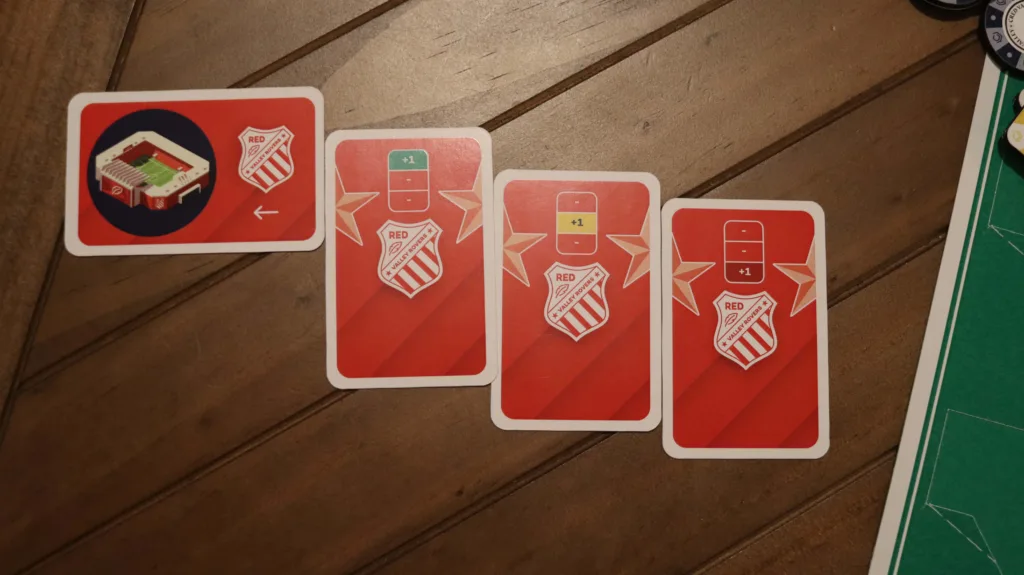
After every match there is some type of off-season which gives the game real pace and the number of players being injured in a game means there is a lot of swapping and subbing of players in and out of the squad so it never feels like two matches repeat simply because of the variables over the matches in a game.
We have had a few games come down to the last match but it’s not so common that the game feels completely balanced, but what game is, so a fair amount of skill is still required to field the most effective team for every game.
Will this replace our Superclub sessions?
That’s a tricky one to answer, when there are just the two of us or if we travel it just might do that. There are more exciting moments and nail-biting finishes in a single game of Superclub Rivals than in a season of Superclub, however, there are only two players taking part so if anyone else wants to join then you will be reverting.
In an ideal world, I would have both games with me but I think Superclub will not be edged out of every game night when there is just my son and I playing. It will make it to the table a lot less because we love Superclub Rivals but we have become so enamoured with Superclub it could never leave us.
In Summary
Exciting and fast. This is the very essence of what makes Superclub Rivals so good. The game is a simpler form of Superclub that takes all the bits that make it great and condenses them into a faster, slicker and more exciting game whilst not taking anything away from Superclub Rivals at all.
Whilst this isn’t a proper review, I can say Superclub Rivals is like Superclub’s crazy, slightly sexier younger sister.
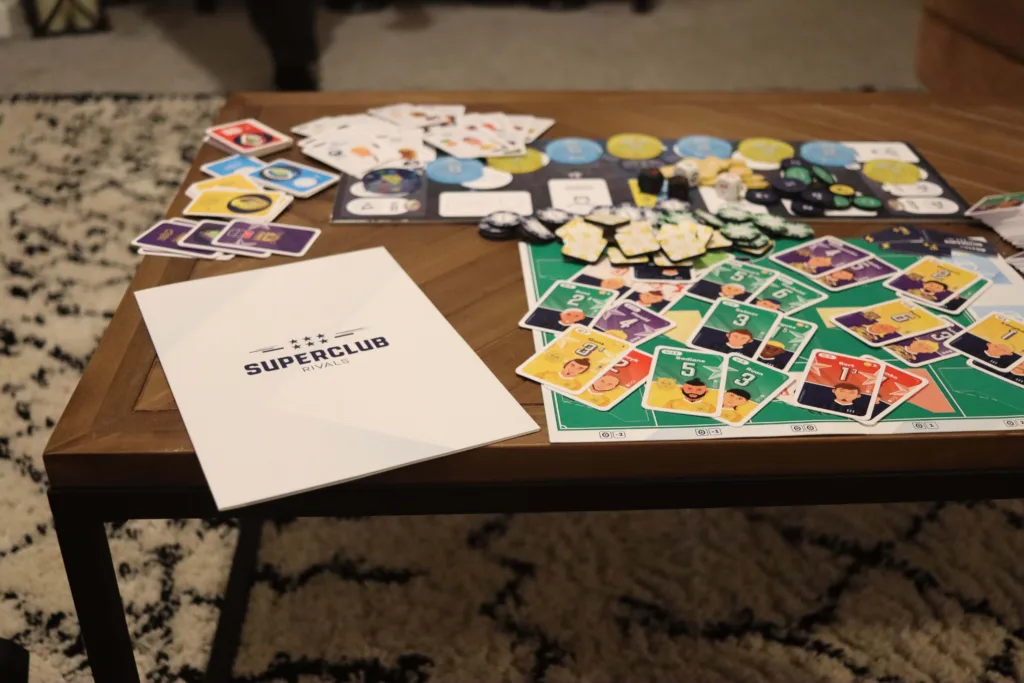
It’s like this, if Superclub was a vehicle it would be a Bentley. You will get yourself and lots of friends where you are going quickly, it is a wonderfully refined and amazing vehicle that can still thrill you with its speed and handling.
If Superclub Rivals were a vehicle it would be a TT Superbike going flat out around the isle of man. It’s the bike you are barely hanging on to as all your adrenaline and fear are being forced into your brain and heart, making you feel sick and at the same time it’s popping its finger into your butt and giving you an orgasm.
NOTES FROM OUR GAME SESSIONS
- Streamlined Gameplay: Superclub Rivals seems to offer a more accessible and condensed version of the original Superclub, making it easier to jump into for both newcomers and experienced players alike.
- Familiar Mechanics: Despite being a standalone game, it retains many familiar mechanics from Superclub, allowing players to instantly recognize and engage with the gameplay.
- Setup and Components: The setup process appears straightforward, though note that the prototype components may differ from the final retail version. Quality components and attention to detail, such as player cards and tokens, contribute to the overall experience.
- Team Drafting: The drafting phase adds strategic depth, with players considering both their team composition and how to hinder their opponent’s choices.
- Off-Season Activities: Dividing gameplay into off-season phases for different tasks like stadium upgrades, training, scouting, and transfers adds variety and strategic decision-making.
- Exciting Matches: The match mechanics, including dice rolls with symbols for various outcomes, create tension and unpredictability reminiscent of real-life football matches.
- Player Injuries and Substitutions: The inclusion of player injuries and substitutions adds another layer of realism and strategy to the game.
- Game Pace and Duration: Matches are described as fast-paced, typically lasting 45 minutes to an hour, making them suitable for shorter gaming sessions.
- Comparisons with Superclub: While Superclub Rivals offers a more exciting and condensed experience, it should be stated clearly that it could not completely replace the original game for all occasions, especially when more players are involved but for 2-player sessions it would be difficult to say no to a game.
Whilst at the time of writing the Superclub Rivals Kickstarter page is not live you can follow this link SUPERCLUB RIVALS and get notified when the game goes live.

